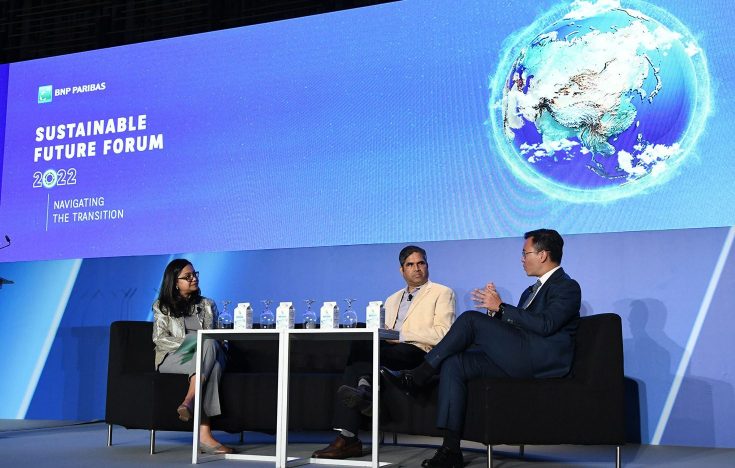Clean tech, collaboration, corporates and investors: transition pathways ahead
Expert speakers and delegates gathered across the globe for the seventh annual BNP Paribas Sustainable Future Forum, focused on navigating the transition to net zero.
Two of Singapore’s leading companies in agriculture and energy generation share how they are embedding sustainability across the value chain.

Global agribusiness giant Olam and Singapore-headquartered energy and urban development company Sembcorp Industries are from very different industries, but they have one thing in common: a commitment to accelerating decarbonisation by embedding sustainability across the value chain.
“Until recently, corporates looked at sustainability from a top-down perspective, but now that drive from the boardroom is being translated into action across all corporate levels and departments,” said Shilpa Gulrajani, Head of Corporate Development & Sustainability, APAC, BNP Paribas, speaking at the recent BNP Paribas Sustainable Future Forum in Singapore.
Introducing speakers from both companies, she added: “Like BNP Paribas, these companies have taken a strong lead in setting targets and are now equipping stakeholders to join the drive toward net zero.”

Until recently, corporates looked at sustainability from a top-down perspective, but now that drive from the boardroom is being translated into action across all corporate levels and departments.
Shilpa Gulrajani, Head of Corporate Development & Sustainability, APAC, BNP Paribas
According to Suresh Sundararajan, CEO of the Olam Ventures incubation platform, its parent company’s influential role in the agriculture sector, which produces a quarter of global greenhouse gases, has created a powerful opportunity to work with supply chain stakeholders.
“Olam is a complex business with more than 1,000 supply chains,” he said. “We have made sustainability a powerful, attractive, compelling value proposition for our employees as well as for all our stakeholders in the supply chain.”
To that end, Olam Ventures supports agricultural and ecological start-ups through a cooperative approach – sharing its expertise and spreading the benefits.

Olam is a complex business with more than 1,000 supply chains. We have made sustainability a powerful, attractive, compelling value proposition for our employees as well as for all our stakeholders in the supply chain.
Suresh Sundararajan, CEO, Olam Ventures
“We learned from our experiments and used the learnings to expand beyond Olam, offering them to the wider industry,” Sundararajan added. “We spent months measuring our Scope 1, 2 and 3 emissions and realised we could create a tech platform to measure our footprint and become an independent business enterprise.”
Sundararajan pointed out that in agriculture, Scope 3 emissions – those created indirectly in the production or consumption of goods or services – contribute more than 90% of the sector’s total. “The key to reducing emissions in agribusiness is to tackle Scope 3 by engaging every stakeholder across the value chain,” he said.
The result was decarbonisation systems platform Terrascope, which helps companies measure their physical emissions and plan for decarbonisation.
Singapore’s Sembcorp Industries uses similar ingenuity to tackle emissions through a combination of stakeholder engagement and technology.
The company, with a power generation portfolio spanning Singapore, China, India, UK, and across Southeast Asia and the Middle East, started by setting ambitious targets for itself – and communicating them extensively.
“We didn’t just make the energy transition peripheral to the organisation but embedded it into our very strategy,” said Eugene Cheng, Group CFO at Sembcorp Industries. “We engaged every business, every leader and every employee in the organisation, so they knew these targets are the very purpose of the organisation.”

We engaged every business, every leader and every employee in the organisation, so they knew these targets are the very purpose of the organisation.
Eugene Cheng, Group CFO, Sembcorp Industries
With ambitious goals to slash gross greenhouse gas emissions from 26 million tonnes to 2.7 million tonnes, quadruple renewable generation capacity to 10 GW, and derive 70% of net income from sustainable businesses by 2025, innovation was needed.
The solution for Sembcorp Industries was to power up its battery technology, creating one of the largest battery portfolios in the UK before exporting this capability to build Singapore’s first-ever 200 MW battery.
Technology has also been an effective enabler for Olam, which established the Olam Direct platform in 2017 to disrupt the first-mile supply chain for farmers. The platform not only provides the direct benefit of better pricing, but also contributes to greater efficiency, decreases Scope 3 emissions and improves social conditions.
“It’s a simple app that disintermediates agents in the supply chain by buying directly from farmers,” said Sundararajan. “Today it’s in 12 countries, serving more than 140,000 farmers.”
Olam Ventures’ AtSource application provides similar benefits for distributors further up the supply chain who use Automated Manifest Systems. The app is now used by more than 300 customers across 30 products and 30 supply chains, according to Sundararajan.
Sembcorp Industries hopes that using financial innovation will enable it to accelerate its decarbonisation efforts while considering the impact on its communities; in particular considering the transition away from coal, which remains an important source of power in emerging economies.
“In the Indian energy market, coal serves 2.5 million Indian households with baseload power – shutting it down would have a massive social impact,” Cheng said.
Instead, it incorporated green innovation into its financing arrangements: “When selling our coal-fired plants, we didn’t want to pass on the emissions to someone else, so we incorporated a carbon emissions reduction incentive,” added Cheng.
This gave the purchaser of Sembcorp Energy India Limited a 9 basis-point reduction on the interest rate for each 1.0% reduction in GHG emissions intensity, subject to a cap of 180 basis points – equivalent to a 20% reduction in emissions.
“Making sustainability a multi-stakeholder journey helps us to increase conviction and confidence among external parties – including investors and financial institutions,” Sundararajan said.
“These days, more than competing to win, it’s about collaborating to win on ESG, it takes a collective effort to see progress,” added Cheng.
By blending purpose and stakeholder engagement with technology and finance, Olam and Sembcorp Industries are making an impact far beyond their individual corporations.
Expert speakers and delegates gathered across the globe for the seventh annual BNP Paribas Sustainable Future Forum, focused on navigating the transition to net zero.